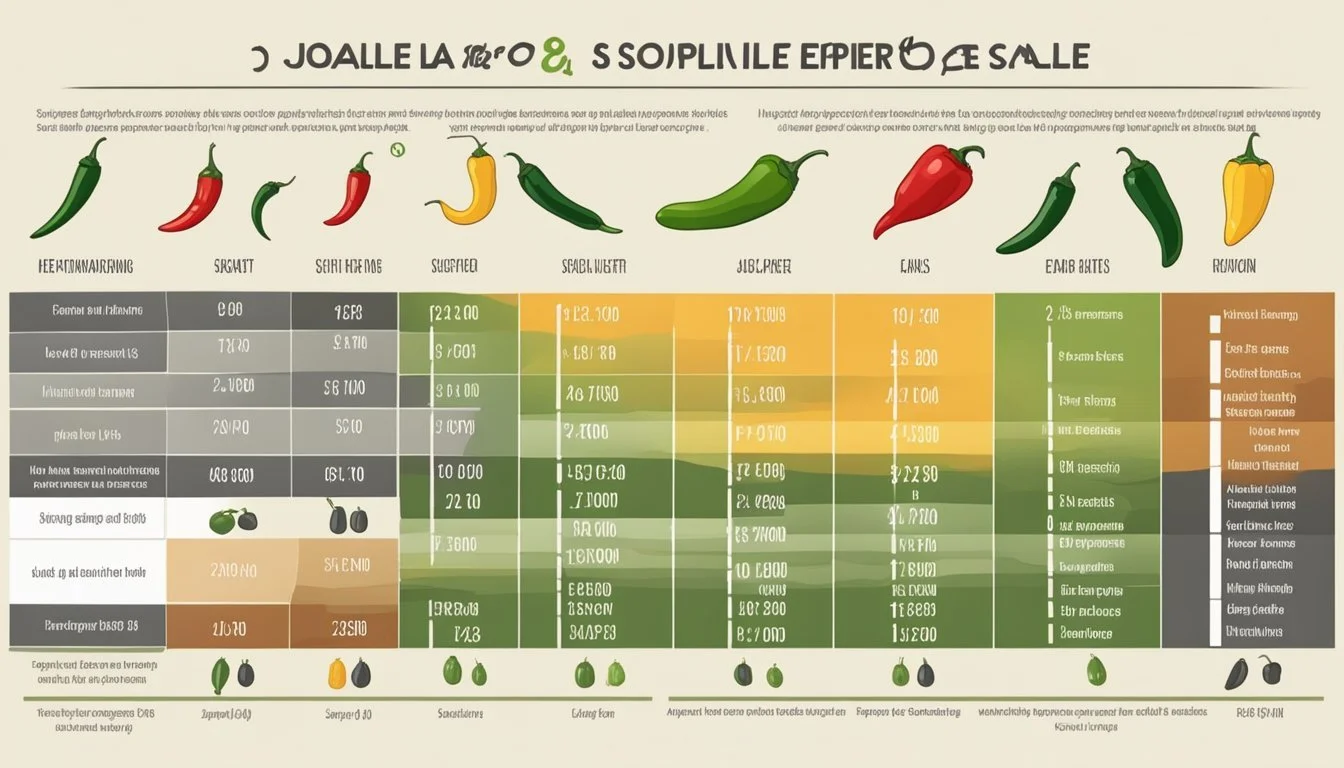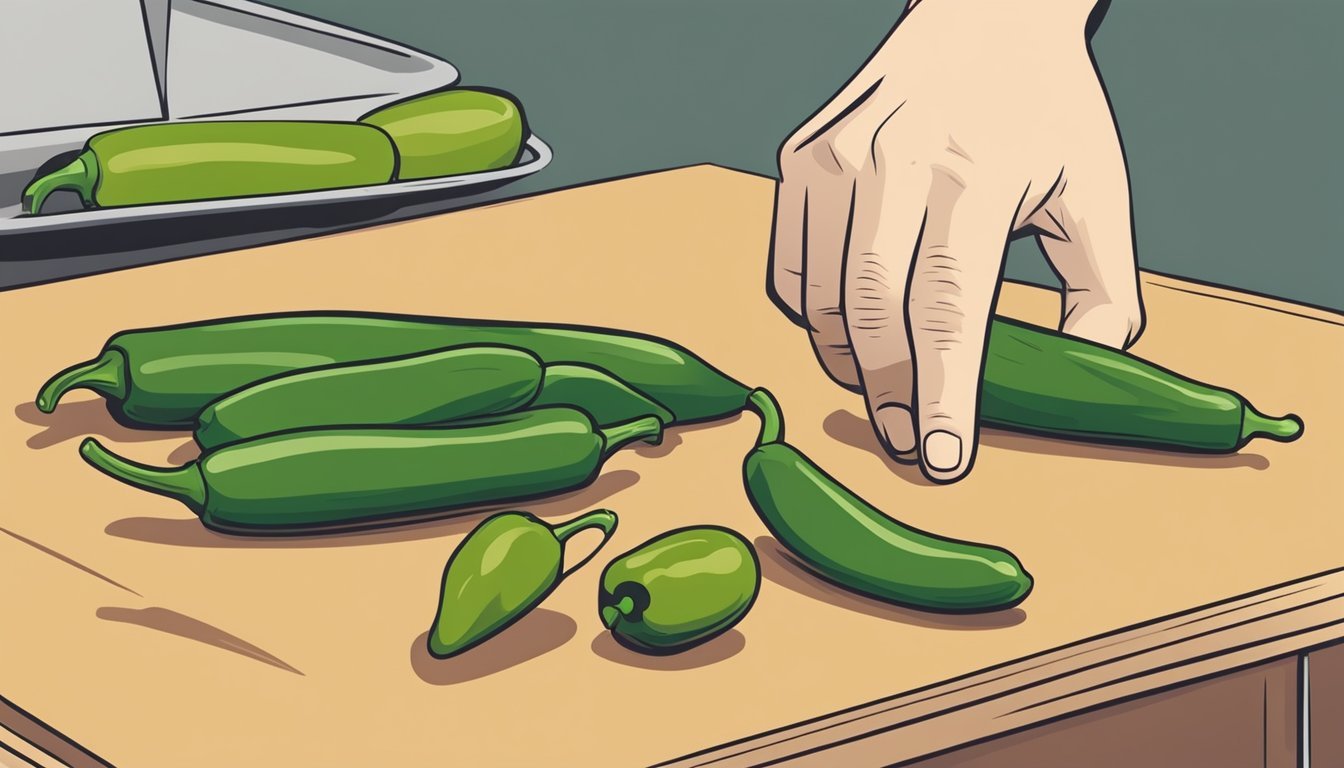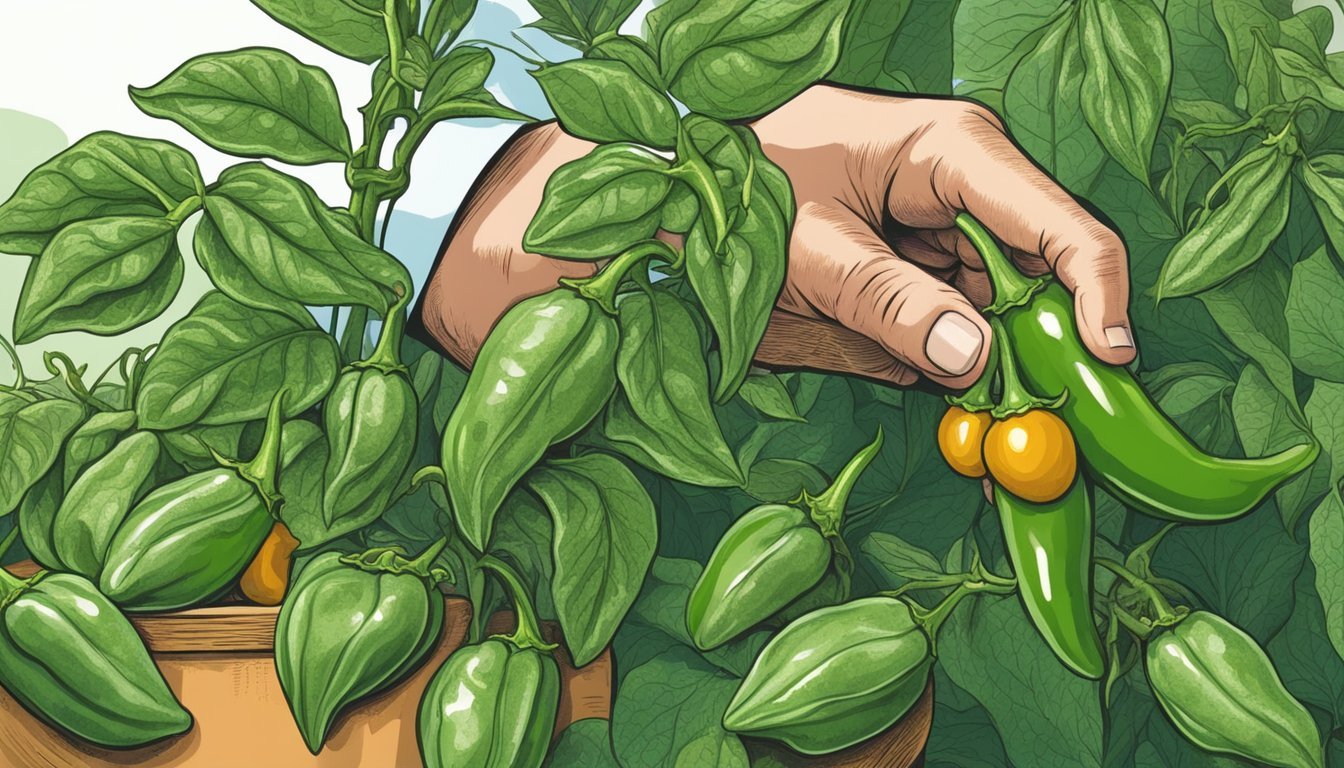How to Substitute Jalapeno for Serrano Pepper
A Spicy Guide
Cooking often requires flexibility, especially when certain ingredients are not available. When a recipe calls for serrano peppers and one finds themselves without, there is no need to abandon the dish. Jalapeño peppers can be an excellent substitute for serranos, although they vary in heat level and size.
Jalapeños are milder and larger with thicker skins than serrano peppers. They are widely available in grocery stores, making them a convenient alternative. To approximate the heat of serranos, one might need to adjust the amount of jalapeños used or add a little extra heat through additional spices.
While serrano peppers typically have a Scoville heat unit (SHU) range from 10,000 to 20,000, jalapeños have a SHU range of 5,000 to 8,000, indicating the heat level is about half as intense. This difference should be taken into account to achieve a similar flavor profile and heat level in the dish. Adjusting the quantity and making allowances for textural differences ensures the jalapeño can be a suitable stand-in for the serrano pepper.
Understanding the Flavor Profiles
When substituting jalapeño for serrano peppers, it's crucial to understand their individual flavor profiles to ensure the desired outcome in taste.
Serrano Peppers
Serrano peppers are known for their bright, sharp heat. They have a Scoville Heat Unit (SHU) range of 10,000 to 23,000, indicating a spiciness that's significantly higher than that of jalapeños. The heat of serrano peppers does not overshadow their flavor, which can be described as crisp and vegetal, with a slight fruity note when ripe.
Jalapeño Peppers
Jalapeño peppers, on the other hand, offer a milder heat and a grassier flavor profile. Their SHU typically ranges from 2,500 to 8,000. While they impart a warmth to dishes, jalapeños also provide a gentle, green vegetable taste, making them less intense than serranos. They are widely used to add a noticeable yet manageable level of heat to a dish without dominating the other flavors present.
Scoville Scale and Heat Levels
Understanding the Scoville Scale is essential for substituting peppers in recipes to achieve the desired heat level. This section will cover the precision of measuring spiciness and directly compare the heat levels of jalapeño and serrano peppers.
Measuring Spiciness
The Scoville Scale gauges the pungency or heat level of chili peppers through Scoville Heat Units (SHU). Developed by Wilbur Scoville, this scale measures capsaicin content—the chemical responsible for the sensation of spiciness. A higher SHU indicates a spicier pepper. For example:
Bell Pepper: 0 SHU
Jalapeño: 2,500 to 8,000 SHU
Serrano: 10,000 to 23,000 SHU
Cayenne Pepper: 30,000 to 50,000 SHU
Heat Comparison of Peppers
When comparing jalapeño and serrano peppers, serranos are typically hotter. Here’s a specific look at their heat levels:
Jalapeño: Ranging from 2,500 to 8,000 SHU, these peppers are considered medium-hot. They have a noticeable heat that is well tolerated by most people.
Serrano: With a range of 10,000 to 23,000 SHU, serranos offer a significantly spicier kick. They can be up to three times hotter than the average jalapeño.
Selecting a Substitute for Serrano Peppers
When a recipe calls for serrano peppers and they are not available, it's essential to understand which substitutes can provide similar heat and flavor. The key is to find a balance between the spiciness and the intended flavor profile of the dish.
Jalapeño as a Serrano Substitute
Jalapeño peppers are the most common and accessible alternative to serrano peppers. Serrano and jalapeño peppers share similar flavor profiles, although serrano peppers tend to be hotter. A general rule of thumb is to use approximately a 1:1 ratio when substituting, but this can be adjusted according to the desired heat level. Note that jalapeño peppers may be milder, so one may need to use more to achieve an equivalent spice level.
For recipes requiring dried serrano pepper, jalapeño powder can be a reasonable substitute, as it imparts a similar earthy and spicy flavor to dishes. Once again, adjust the quantity based on taste preference and the heat of the jalapeño powder, which can vary.
Other Pepper Alternatives
There are numerous other peppers one can use in place of serrano peppers. Each of these alternatives brings a unique balance of heat and flavor that can complement different types of dishes.
Cayenne Peppers: Much hotter than serrano peppers, so use sparingly. Cayenne powder is easier to control for heat adjustment.
Fresno Peppers: Similar to jalapeños but fruitier, which can add a unique flavor twist.
Banana Peppers: Milder than serranos; use when a less spicy outcome is desired.
Poblano Pepper: Another milder option but can add depth to a dish when roasted and peeled.
Anaheim Pepper: This pepper has a mild to medium heat level, suitable for those looking to maintain some spice without overpowering the dish.
Bell Pepper: Ideal for those who want the pepper flavor without any heat, bell peppers (What wine goes well with bell peppers?) are sweet and can also provide a similar texture within various recipes.
Select peppers that complement the flavor profile of the dish while providing the right level of heat. Adjust quantities based on each pepper's spiciness compared to serrano peppers to achieve the desired taste.
Serrano and Jalapeño in Recipes
When substituting Serrano peppers for Jalapeños in recipes, one must consider the difference in heat levels and the texture that each pepper brings to the dish. Serranos are hotter and less fleshy than Jalapeños, which may affect the recipe's outcome.
Fresh and Dried Uses
Fresh Serranos are typically hotter than fresh Jalapeños and can be used in a range of dishes, such as salsas, salads, and rice dishes. When substituting, use fewer Serranos to match the heat level of Jalapeños. For dried uses, powdered Serrano can replace jalapeño powder in a 1:2 ratio, due to the higher spice level.
Sauces and Salsas
Both peppers contribute a characteristic kick to sauces and salsas. In salsa recipes, one could swap a Jalapeño for a Serrano if a spicier taste is desired. If using Serranos instead, one might consider reducing the quantity to keep the salsa from becoming too fiery. When making hot sauces, the substitutions are similar, but due to the liquid form, adjustments can be made to taste as the sauce simmers.
Main Dishes and Sides
In main dishes and sides such as soups, stews, and rice dishes, the pepper’s role ranges from a subtle enhancement to a bold, defining element. Serranos can be substituted for Jalapeños based on the desired heat level; however, they should be used more sparingly. Their heat can be impactful in dishes like soups and stews, while in salads and rice dishes, they contribute to the overall flavor profile without overwhelming. If Jalapeños are specified in a recipe but only Serranos are available, start with half the amount and adjust according to taste.
Adjusting Heat in Dishes
When substituting jalapeño for serrano pepper, one must carefully adjust the heat levels to match the dish's requirements and the diners' heat tolerance. Both peppers belong to the Capsicum annuum species and will affect the spiciness of a dish.
Controlling Spiciness with Peppers
Jalapeño Peppers:
Milder than serranos: Ranging from 2,500 to 8,000 Scoville Heat Units (SHU).
Adjustment: Use a greater quantity of jalapeño to match the heat of serrano peppers.
Serrano Peppers:
Hotter than jalapeños: Approximately 10,000 to 23,000 SHU.
Replacement: Generally, one can substitute a serrano with half to two-thirds the amount of jalapeño to reduce spiciness.
Tips for Management:
Introduce gradually: Add peppers incrementally to control the heat.
Seeds and membrane: Remove these parts to tone down the heat as they contain concentrated capsaicin.
Consistent size: Dice peppers finely for even heat distribution.
Alternative Spicing Methods
Using Dried Spices:
Cayenne Pepper Powder: Hotter than fresh peppers, use sparingly to increase heat.
Red Pepper Flakes: Offer a different texture and are less spicy; use to maintain some heat without overpowering.
Smoked Paprika: Provides a smoky flavor and minimal heat; suitable for a more subtle spiciness.
Incorporating Spices into Dishes:
Balance: Pair spices with other ingredients like onions, garlic, or herbs to achieve a well-rounded flavor.
Timing: Add spices early in the cooking process to mellow their intensity, or later for a more pronounced heat.
Taste Testing: Always taste as you go to ensure the ideal spiciness level is reached.
Proper Preparation Techniques
When substituting jalapeno for serrano pepper, the chef must keep in mind that while the two peppers share similarities, they vary in size and heat intensity. Preparation involves meticulous handling and distinct cooking methods to achieve the desired texture and flavor balance.
Handling and Cutting
The chef should wear gloves when handling jalapenos to prevent skin irritation. They must rinse the peppers thoroughly before slicing to ensure cleanliness. To match serrano's smaller size, one should finely dice the jalapeno. This not only approximates the texture but also disburses the heat more evenly throughout the dish.
Seed removal: To reduce heat, remove the seeds and membranes.
Dicing:
Fine dice for salads or garnishes for precision and uniformity.
Rough chop for stir-fries where the pepper's presence is more integral to the presentation.
Cooking Approaches
Jalapenos require specific cooking techniques to resemble the characteristics of serrano peppers in recipes.
Quick-cooking methods:
Sautéing: Briefly sauté jalapenos to retain their crisp texture, similar to how one would cook serranos.
Stir-frying: A rapid method that imbues dishes with a smoky flavor and keeps the jalapenos firm.
Slow-cooking methods:
Incorporating jalapenos into sauces or stews with a long simmering time will mellow their flavor and soften their texture, akin to serranos cooked in the same style.
A chef's keen attention to these techniques will ensure that the substitution maintains the integrity of the culinary masterpiece.
Gardening and Harvesting
When it comes to substituting jalapeños for serrano peppers in recipes, understanding the nuances of gardening and harvesting these peppers can make a significant difference in their flavor and heat profile. Both varieties require similar growing conditions but differ in their heat levels and ideal harvesting times.
Growing Peppers at Home
Jalapeños and serrano peppers flourish in similar garden conditions – they prefer a warm environment with plenty of sunlight. For optimal growth, they should receive at least 6 hours of full sun per day. Starting seeds indoors is common; they should be planted about 1/4 inch deep in moist, well-draining soil. Employing a heat mat can be beneficial to maintain a consistent temperature. Once germinated, providing the young plants with 12-16 hours of light, either from the sun or grow lights, will encourage strong development.
When transplanting outdoors:
Ensure the risk of frost has passed and the soil temperature is at least 65°F (18°C).
Maintain a spacing of 14-24 inches between plants, with rows spaced 24-36 inches apart.
Consistent watering is key, but avoid overwatering to prevent root rot.
Staking may be necessary as the pepper plants grow to support the weight of the fruit.
Soil: Fertile, well-drained
Watering: Regular, consistent, avoiding waterlogged soil
Fertilization: Balanced fertilizer, such as a 10-10-10 NPK ratio
Picking and Storing
Both jalapeños and serrano peppers are typically harvested when they reach their mature size, which is approximately 2-4 inches in length for serrano peppers, and 3-5 inches for jalapeños. Serrano peppers start as green and can turn red as they fully ripen. Jalapeños also change from green to red, though many prefer picking them while they're still green, as this is when they are most commonly used in culinary dishes.
To harvest properly:
Use garden shears or a sharp knife to cut the pepper from the plant to prevent damage.
Leave a short amount of stem attached which can help preserve the pepper's freshness.
For storage:
Refrigerate peppers in produce bags to maintain freshness for several days up to two weeks.
For longer storage, both types of peppers can be dried, frozen, or pickled.
Harvesting: When they reach the desired size and color Storage Conditions: Cool, dry, and refrigerated for fresh peppers; can be dried, frozen, or pickled for long-term storage
Pepper Variations and Cultural Significance
Chili cultivars display a wide range of heat levels, flavors, and appearances, each signifying its unique role in culinary traditions worldwide.
Diversity of Chili Cultivars
The chili pepper's diversity is vast, with species ranging from the bell pepper, which has no heat and is widely used in dishes for its sweet flavor and crisp texture, to the bhut jolokia, also known as the ghost pepper, famed for its extreme heat. Peppers like the serrano and jalapeño vary in pungency and are staples in Mexican cuisine. While serrano peppers are typically hotter than jalapeños, they can be substituted in recipes based on the desired spice level. Chipotle peppers, which are smoked jalapeños, offer a distinctive depth of flavor. Bringing in variation not just in culinary creations, their heat level is also measured in Scoville Heat Units (SHUs), indicating the capsaicin concentration.
Bell peppers: 0 SHU, sweet, crisp.
Jalapeño peppers: 5,000-8,000 SHU, medium heat, thick-fleshed.
Serrano peppers: 10,000-20,000 SHU, higher heat, thinner flesh.
Bhut jolokia: Over 1,000,000 SHU, extremely hot.
Thai bird’s eye chilis: 50,000–100,000 SHU, small size, intense heat.
Peppers in World Cuisines
Chili peppers are integral to many world cuisines, contributing both flavor and cultural identity. Mexican cuisine utilizes a variety of peppers, including jalapeños, serranos, and chipotle peppers, to create layers of flavor in dishes such as salsa and chili con carne. Thai cuisine often incorporates the Thai bird’s eye chilis, which introduce a fiery heat to curries, and salads. Each pepper type carries cultural significance that transcends its culinary use, often acting as a symbol of cultural heritage and regional pride.
Conclusion
When substituting jalapeño peppers for serrano peppers, it’s crucial to consider the variations in heat level and size. Jalapeño peppers, being milder and larger, may require adjustments in quantity to achieve the desired flavor profile and heat intensity.
To compensate for the heat difference, one might use a ratio of approximately 1.5:1, implying an increase of jalapeño usage by half more than serrano peppers called for. It is beneficial to taste and adjust, as the heat can vary even within the same pepper variety.
Steps for Substituting Jalapeño:
Chop more: Use more jalapeño peppers to equal the spiciness of serranos.
Remove seeds optionally: To reduce heat while maintaining flavor, seeds can be removed.
Cook as usual: Substitute in raw or cooked recipes as needed.
Remember, the texture of jalapeños is thicker, which may slightly affect the final dish. In cases where texture is important, adjustments may be needed to the cooking time or preparation method.
By bearing in mind these considerations, chefs and home cooks can successfully incorporate jalapeño peppers into their dishes as a substitute for serrano peppers, maintaining a balance of flavor and spice.










